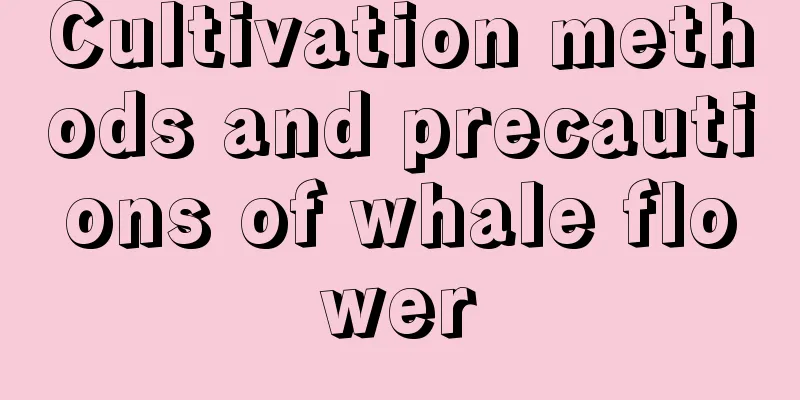Cultivation methods and precautions of whale flower

How to grow whale flowersoilWhale flower likes soil with good drainage and breathability. Therefore, it requires loose, fertile and well-drained soil. You can use a mixture of leaf mold, sawdust, and perlite, and add some fine sand to increase air permeability. Water and fertilizer managementWhale flower likes a humid environment. During the growing period, it needs to be given enough water to keep the soil in the pot moist, and at the same time, the humidity of the air around it should be increased by spraying water. When the temperature is high in summer and low in winter, reduce the water supply and keep the soil in the pot dry, which is more conducive to the growth of whale flower. Whale flower is a fertilizer-loving plant and should be given liquid fertilizer regularly. During the growing season, fertilizer can be applied every 15 to 20 days, preferably in small amounts and frequently. Whale flower is generally applied with more nitrogen and phosphorus fertilizers in spring and summer, and more potassium fertilizers in autumn. When the flower buds are growing, you can apply liquid fertilizer mainly composed of phosphorus fertilizer 1 to 2 times. Light and temperatureWhale flower likes warm, humid and semi-shady environment. The suitable temperature for growth is between 18 and 22°C. The wintering temperature should be above 10°C, and the daytime temperature in winter needs to be kept above 15°C. Whale flower likes bright indirect light, and the eaves or windowsills with good lighting are suitable breeding places. Normally, you can let the whale flower get more exposure to sunlight, but in the summer, you must be careful that the whale flower should avoid direct sunlight. Things to note when growing whale flowersReproduction methodWhale flower is often propagated by cuttings, division or sowing, which can be done in spring or autumn. Other considerationsDuring the cultivation of whale flower, pruning and trimming are required frequently. When the whale flower blooms, you should stop fertilizing, keep the soil drier, and reduce watering. |
<<: Cultivation methods and precautions of American mint
>>: Cultivation methods and precautions of Tumi
Recommend
Water and fertilizer management and flowering period control of Rhododendron dew
1. Fertilizer management of dewdrop azalea 1. Soi...
How to loosen the soil for a peace thyme tree
1. Why do we need to loosen the soil? 1. Increase...
How to make blue snow flower bloom
1. Environment We need to give it the environment...
When is the best time to plant soybeans?
Soybean, also known as soybean , is native to Chi...
When is the best time to plant kiwi fruit trees?
The soil for planting kiwi trees must be fertile,...
The characteristics of the molting of the red-billed
The characteristics of the molting of the red-bil...
When is the best time to sow the seeds of Chonglou
Planting time of Polygonum multiflorum Paris poly...
Does Carnation prefer shade or sun?
Does Carnation prefer shade or sun? Dianthus is e...
Will lucky bamboo die if its roots are cut? How to keep it after cutting its roots?
1. Will lucky bamboo die if its roots are cut? Lu...
How does the purple bamboo plum survive the winter? Will it shed its leaves in winter?
1. How to spend the winter It likes warmth and ca...
Can Dendrobium officinale be grown in the north? Is Dendrobium officinale drought-resistant?
1. Can it be raised in the north? Dendrobium offi...
The efficacy and function of rapeseed leaves, what are the characteristics of rapeseed
1. Efficacy and function of rapeseed leaves Rapes...
Environmental conditions and characteristics of navel orange growth
Environmental conditions and requirements for nav...
What are the little black bugs in chrysanthemums and how to get rid of them
1. What is The small black insects that appear in...
How to propagate the four-leafed lily
How to propagate the four-leafed lily There are t...









